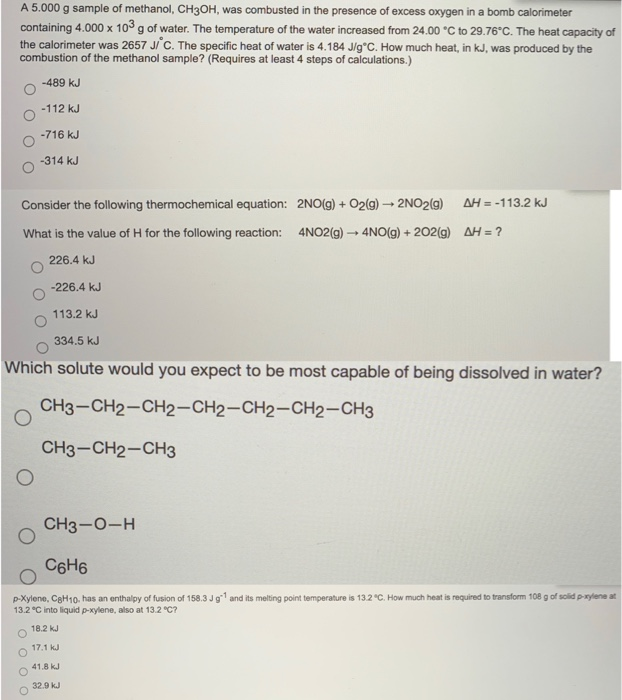A 5.000 g sample of methanol, CH3OH, was combusted in the presence of excess oxygen in a bomb calorimeter containing 4.000 x 103 g of water. The temperature of the water increased from 24.00 °C to 29.76°C. The heat capacity of the calorimeter was 2657 JiC. The specific heat of water is 4.184 J/g°C. How much heat, in kJ, was produced by the combustion of the methanol sample? (Requires at least 4 steps of calculations.) -489 kJ -112 kJ -716 kJ -314 kJ
A 5.000 g sample of methanol, CH3OH, was combusted in the presence of excess oxygen in a bomb calorimeter containing 4.000 x 103 g of water. The temperature of the water increased from 24.00 °C to 29.76°C. The heat capacity of the calorimeter was 2657 JiC. The specific heat of water is 4.184 J/g°C. How much heat, in kJ, was produced by the combustion of the methanol sample? (Requires at least 4 steps of calculations.) -489 kJ -112 kJ -716 kJ -314 kJ
General Chemistry - Standalone book (MindTap Course List)
11th Edition
ISBN:9781305580343
Author:Steven D. Gammon, Ebbing, Darrell Ebbing, Steven D., Darrell; Gammon, Darrell Ebbing; Steven D. Gammon, Darrell D.; Gammon, Ebbing; Steven D. Gammon; Darrell
Publisher:Steven D. Gammon, Ebbing, Darrell Ebbing, Steven D., Darrell; Gammon, Darrell Ebbing; Steven D. Gammon, Darrell D.; Gammon, Ebbing; Steven D. Gammon; Darrell
Chapter6: Thermochemisty
Section: Chapter Questions
Problem 6.113QP: A 10.00-g sample of acetic acid, HC2H3O2, was burned in a bomb calorimeter in an excess of oxygen....
Related questions
Question
Solve first 2 questions

Transcribed Image Text:A 5.000 g sample of methanol, CH3OH, was combusted in the presence of excess oxygen in a bomb calorimeter
containing 4.000 x 103 g of water. The temperature of the water increased from 24.00 °C to 29.76°C. The heat capacity of
the calorimeter was 2657 JiC. The specific heat of water is 4.184 J/g°C. How much heat, in kJ, was produced by the
combustion of the methanol sample? (Requires at least 4 steps of calculations.)
-489 kJ
-112 kJ
-716 kJ
-314 kJ
Expert Solution
This question has been solved!
Explore an expertly crafted, step-by-step solution for a thorough understanding of key concepts.
This is a popular solution!
Trending now
This is a popular solution!
Step by step
Solved in 3 steps

Knowledge Booster
Learn more about
Need a deep-dive on the concept behind this application? Look no further. Learn more about this topic, chemistry and related others by exploring similar questions and additional content below.Recommended textbooks for you

General Chemistry - Standalone book (MindTap Cour…
Chemistry
ISBN:
9781305580343
Author:
Steven D. Gammon, Ebbing, Darrell Ebbing, Steven D., Darrell; Gammon, Darrell Ebbing; Steven D. Gammon, Darrell D.; Gammon, Ebbing; Steven D. Gammon; Darrell
Publisher:
Cengage Learning

Chemistry: Principles and Practice
Chemistry
ISBN:
9780534420123
Author:
Daniel L. Reger, Scott R. Goode, David W. Ball, Edward Mercer
Publisher:
Cengage Learning

Chemistry
Chemistry
ISBN:
9781305957404
Author:
Steven S. Zumdahl, Susan A. Zumdahl, Donald J. DeCoste
Publisher:
Cengage Learning

General Chemistry - Standalone book (MindTap Cour…
Chemistry
ISBN:
9781305580343
Author:
Steven D. Gammon, Ebbing, Darrell Ebbing, Steven D., Darrell; Gammon, Darrell Ebbing; Steven D. Gammon, Darrell D.; Gammon, Ebbing; Steven D. Gammon; Darrell
Publisher:
Cengage Learning

Chemistry: Principles and Practice
Chemistry
ISBN:
9780534420123
Author:
Daniel L. Reger, Scott R. Goode, David W. Ball, Edward Mercer
Publisher:
Cengage Learning

Chemistry
Chemistry
ISBN:
9781305957404
Author:
Steven S. Zumdahl, Susan A. Zumdahl, Donald J. DeCoste
Publisher:
Cengage Learning


Chemistry: An Atoms First Approach
Chemistry
ISBN:
9781305079243
Author:
Steven S. Zumdahl, Susan A. Zumdahl
Publisher:
Cengage Learning

Chemistry by OpenStax (2015-05-04)
Chemistry
ISBN:
9781938168390
Author:
Klaus Theopold, Richard H Langley, Paul Flowers, William R. Robinson, Mark Blaser
Publisher:
OpenStax